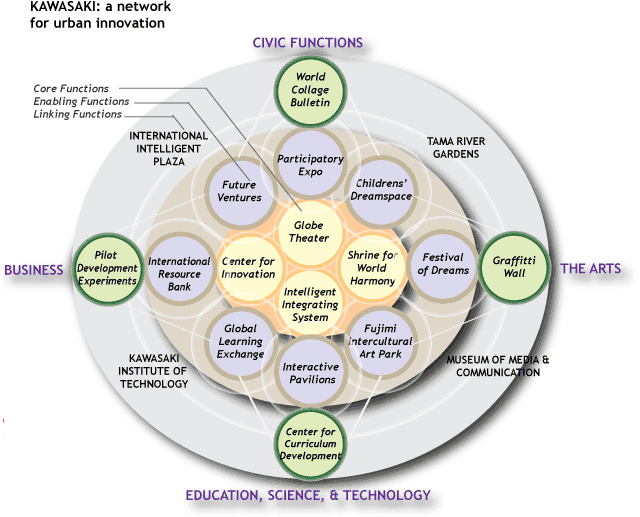Zann Gill’s submission to the competition for Kawasaki, Japan, sponsored by the Japan Association for Planning Administration and the Mainichi Newspapers, with collaboration of ten ministries and three agencies of the Japanese government, tied with Matsushita for First Place and won the Award of the Mayor of Kawasaki. This submission illustrated the power of evolutionary principles to drive innovation networks.

Today’s next wave will harness web 2.0 and ubiquitous computing to transform social networks into Innovation Networks capable of driving innovation and bottom-up regional initiatives.
New Media for Civic Participation: the World Collage Bulletin
Zann Gill’s Plan for Kawasaki, information city of the 21st century, anticipated need for this technology, proposing an ecosystem for innovation comprised of sixteen collaboratively autonomous components to enlist participation of different segments of the population, as shown in the diagram below.

These sixteen participatory mechanisms were linked in an Innovation Network for Kawasaki, Japan to encourage ongoing collaboration among corporate leaders, universities, governments, private and public organizations, and individuals. The northern half of the diagram shows civic components. Primary functions of the civic components in the northern half of the diagram, such as the World Collage Bulletin, are social interaction; public inquiry; referendum; assembly; communication and collaboration. The western half shows components that focus on innovation and private enterprise. Primary functions of the business and enterprise components in the western half of the diagram are to stimulate invention, implement promising innovation, matching resources with entrepreneurial needs to launch international ventures.
Tapping Civic Imagination: from children to the wisdom of elders
The eastern half of the diagram shows artistic and celebrational components. The primary functions of the arts components in the eastern half of the diagram are recreation and sensory stimulus; appreciating nature and the family of humanity; celebration and intercultural festivals; creative inspiration of the arts; and meditation and sacred space. The southern half of the diagram contains components associated with science, technology, and education.

The four core components in the center of the diagram manifest Kawasaki’s leadership in each of these four domains. Following the Kawasaki competition, the Japanese government organization then called MITI (the Ministry of Trade and Industry) proposed to the Japanese government to jointly design a “City of the Future” the so-called Multifunction Polis City of the Future in Australia.
In the core, influencing all other components, the Globe Theater and Shrine for World Harmony will be the two major landmarks of Kawasaki’s Agora of the Future.
The Shrine for World Harmony is an introspective, ritualistic, and meditative environment, inviting visitors to participate in Japanese tradition. The Globe Theater is proposed as a collaborative problem-solving environment, or collaboratory, providing a powerful tool for civic. business, and university policy-makers to think about global problems using decision support tool through and interactive display of its evolving database. People entering this luminous Eartharium can use its graphic display to visualize our interdependence as never before.
Educational institutions, from primary school through university, should play a core role, not only to develop analytical skills, but in to cultivate imagination, with the aid of components such as the
Children’s Dreamspace and Story Exchange to initiate cross-cultural exchange at an early age. Primary functions of science, technology, and education components in the southern half of the diagram are international intellectual exchange, hypothesis formation and testing, cognitive integration, and scenario construction.
Zann Gill moved to Australia for six years to work on this project. But, although innovation was a popular discussion topic, implementing Innovation Networks, whether for urban innovation or at the scale of individual institutions, threatens managers who thrive in the traditional top-down control paradigm. The Australian project, driven by big government and large real estate interests became a case study in how to block innovation.
